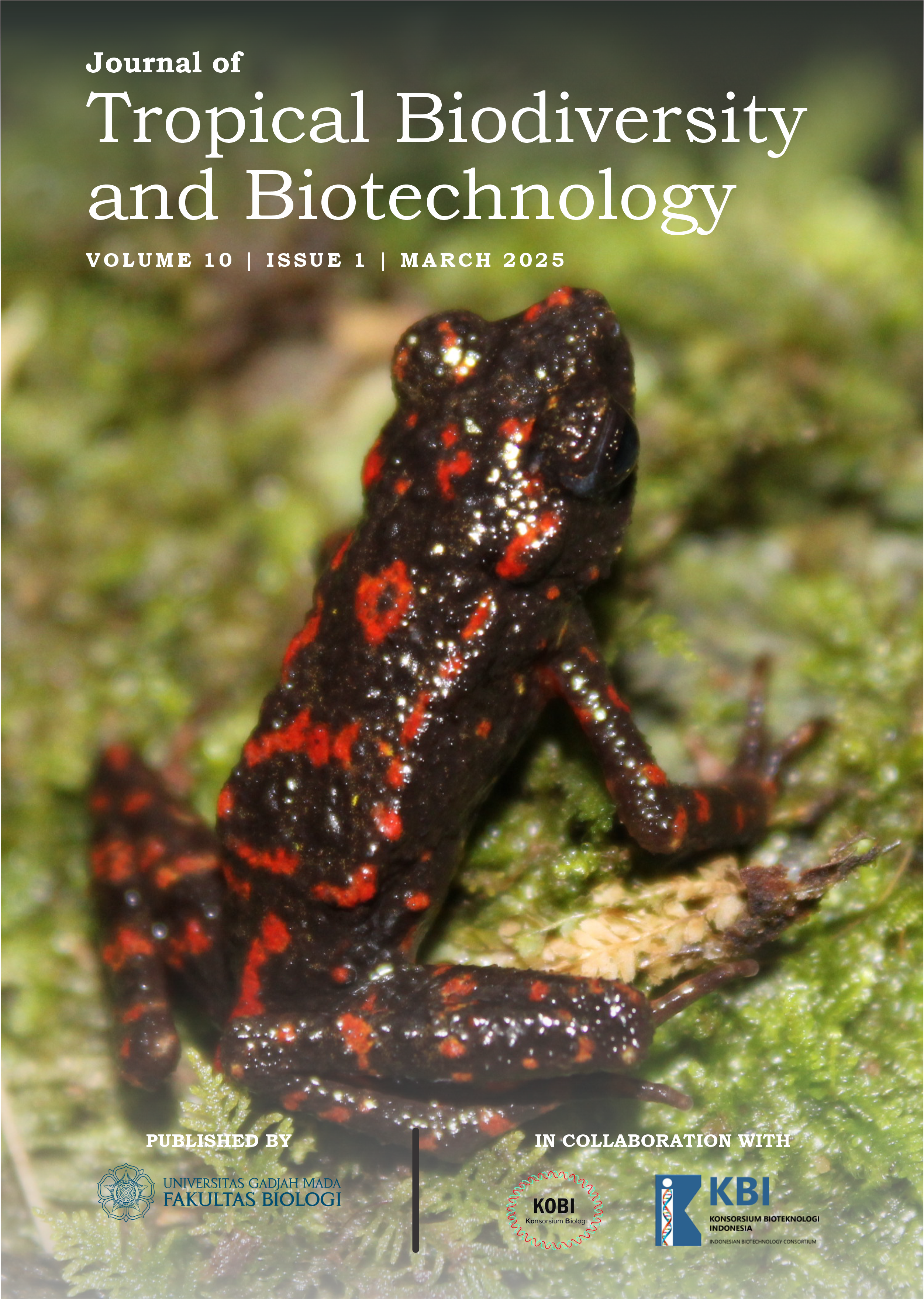Effect of Benzyl-Adenine and Thidiazuron on In Vitro Multiplication of Ginger (Zingiber officinale Rosc.) Shoots
Abstract
The wilt disease caused by Ralstonia solanacearum and the leaf spot disease caused by Phyllosticta sp. are significant constraints in ginger cultivation as they can lead to crop failure. One approach to eliminating these diseases is to use disease-free ginger plantlets obtained through tissue culture propagation. This study investigated the influence of plant growth regulators, i.e., Benzyl Adenine (BA) and Thidiazuron (TDZ), on the in vitro multiplication of large white ginger shoots. The tested treatments included combinations of BA (0, 1, 2, 3 mg L-1) and TDZ (0, 0.1, and 0.2 mg L-1), with ten replicates each. A complete randomised factorial experimental design was employed. The observed variables were shoot height, number of shoots, number of leaves, and number and length of roots at 2, 4, 6, and 8 weeks of age. The results indicated an interaction between TDZ and BA for shoot number and root length. The highest numbers of shoots were obtained after eight weeks using 0.1 mg L-1 TDZ alone without BA. Meanwhile, the longest roots were obtained after eight weeks using a specific combination of TDZ and BA concentrations. Based on this study, we proposed a strategy to implement this protocol to induce the formation of shoots, leaves, and roots in a multistep tissue culture propagation.
References
Adriani, A.R., Gusnawati, H.S. & Khaeruni, A., 2012. Respon ketahanan berbagai varietas tomat terhadap penyakit layu bakteri (Ralstonia solanacearum). Jurnal Agroteknologi, 2(2), pp.63-68.
Azhari, H.N., Yap, S.S. & Nour, A.H., 2017. Extraction and chemical compositions of ginger (Zingiber officinale Roscoe) essential oils as cockroaches repellent. Australian Journal of Basic and Applied Sciences, 11(3), pp.1-8.
Chaidir, L., 2019. Effect of sucrose on in vitro bud multiplication of torch ginger (Etlingera elatior). IOP Conference Series: Earth and Environmental Science, 334(1), pp.1-3. doi: 10.1088/1755-1315/334/1/012015.
El Sayed, S.M. & Moustafa, R. A., 2016. Effect of combined administration of ginger and cinnamon on high-fat diet induced hyperlipidemia in rats. Journal of Pharmaceutical, Chemical and Biological Sciences, 3(4), pp.561-572.
Fauzia, Y.F. & Nurcahyanti, S.D., 2020. Ketahanan tiga klon jahe (Zingiber officinale Rosc.) terhadap penyakit layu bakteri (Ralstonia solanacearum). Jurnal Proteksi Tanaman Tropis, 1(2), pp.62-69.
Grąbkowska, R., Sitarek, P. & Wysokińska, H., 2014. Influence of thidiazuron (TDZ) pretreatment of shoot tips on shoot multiplication and ex vitro acclimatization of Harpagophytum procumbens. Acta Physiologiae Plantarum, 36(7), pp.1661–1672. doi: 10.1007/s11738-014-1541-9.
Guji, M.J., Yetayew, H.T. & Kidanu, E.D., 2019. Yield loss of ginger (Zingiber officinale) due to bacterial wilt (Ralstonia solanacearum) in different wilt management systems in Ethiopia. Agriculture & Food Security, 8, 5. doi: 10.1186/s40066-018-0245-6
Guo, B. et al., 2011. Thidiazuron: A multi-dimensional plant growth regulator. African Journal of Biotechnology, 10(45), pp.8984–9000. doi: 10.5897/AJB11.636.
Gupta, N. et al., 2020. A review on micropropagation culture method. Asian Journal of Pharmaceutical Research and Development, 8(1), pp.86–93. doi: 10.22270/ajprd.v8i1.653.
Kumar, N. & Reddy, M.P., 2011. In vitro plant propagation: a review. Journal of Forest and Environmental Science, 27(2), pp.61-72.
Lestari, E.G., 2011. Peranan zat pengatur tumbuh dalam perbanyakan tanaman melalui kultur jaringan. Jurnal Agrobiogen, 7(1), pp.63–68.
Lestari, E.G., 2016. Pemuliaan tanaman melalui induksi mutasi dan kultur in vitro, First Ed., Indonesia: IAARD Press.
Lestari, E.G., Nugraha, M.F.I. & Yunita, R., 2023. The Formula media in vitro Propagation and Conservation of Ludwigia sp. Journal of Tropical Biodiversity and Biotechnology, 8(1), jtbb75947. doi: 10.22146/jtbb.75947
Mehaboob, V.M. et al., 2019. Direct organogenesis and microrhizome production in ginger (Zingiber officinale Rosc.). Journal of Pharmacognosy and Phytochemistry, 8(3), pp.2880-2883.
Ministry of Agriculture, 2001. Decree on the release of large white ginger varieties Cimanggu 1, No. 109/Kpts/Tp. 240/2/2001.
Sabulal, B. et al., 2006. Caryophyllene-rich rhizome oil of Zingiber nimmonii from South India: Chemical characterization and antimicrobial activity. Phytochemistry, 67(22), pp.2469-2473. doi: 10.1016/j.phytochem.2006.08.003
Semwal, R.B. et al., 2015. Important nutraceutical principles from ginger. Phytochemistry, 17, pp.554-568. doi: 10.1016/j.phytochem.2015.07.012.
Seran, T.H., 2013. In vitro propagation of ginger (Zingiber officinale Rosc.) through direct organogenesis: A review. Pakistan Journal of Biological Sciences, 16(24), pp.1826–1835. doi: 10.3923/pjbs.2013.1826.1835.
Shahrajabian, M. H., Sun, W. & Cheng, Q., 2019a. Clinical aspects and health benefits of ginger (Zingiber officinale) in both traditional Chinese medicine and modern industry. Acta Agriculturae Scandinavica, Section B — Soil & Plant Science, 69(6), pp.546–556. doi: 10.1080/09064710.2019.1606930.
Shahrajabian, M. H., Sun, W., & Cheng, Q., 2019b. Pharmacological uses and health benefits of ginger (Zingiber officinale) in traditional asian and ancient chinese medicine, and modern practice. Notulae Scientia Biologicae, 11(3), pp. 309–319. doi: 10.15835/nsb11310419.
Shahzad, H. et al., 2023. Medicinal biospecificity of ginger and its efficacious bioactive compounds in the context of its biological activities against predominant health issues: Current study and new avenues. Biology, Medicine, & Natural Product Chemistry, 12(1), pp.371–389. doi: 10.14421/biomedich.2023.121.371-389
Shan, X., Li, D., & Qu, R., 2000. Thidiazuron promotes in vitro regeneration of wheat and barley. In Vitro Cellular & Developmental Biology-Plant, 36, pp.207-210.
Shaheen A., et al., 2020. Micropropagation of licorice (Glycyrrhiza glabra L.) by using intermediate nodal explants. Chil. J. Agric. Res., 80(3), pp.326–333. doi: 10.4067/S0718-58392020000300326.
Sharifi-Rad, M. et al, 2017. Plants of the genus Zingiber as a source of bioactive phytochemicals: From tradition to pharmacy. Molecules, 22(12), pp.2-20. doi: 10.3390/molecules22122145.
Sitinjak, R.R., 2010. Pemanfaatan meristem dalam teknik kultur jaringan. Jurnal Akademia, 14(4), pp.56–59.
Tegen, H., & Mohammed, W., 2016. The role of plant tissue culture to supply disease free planting materials of major horticultural crops in Ethiopia. Journal of Biology, Agriculture and Healthcare, 6(1), pp.122-129.
Zahid, N.A., Jaafar, H.Z.E. & Hakiman, M., 2021. Micropropagation of ginger (Zingiber officinale Roscoe) ‘bentong’ and evaluation of its secondary metabolites and antioxidant activities compared with the conventionally propagated plant. Plants, 10(4), 630. doi: 10.3390/plants10040630




